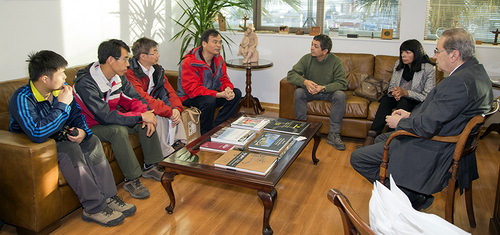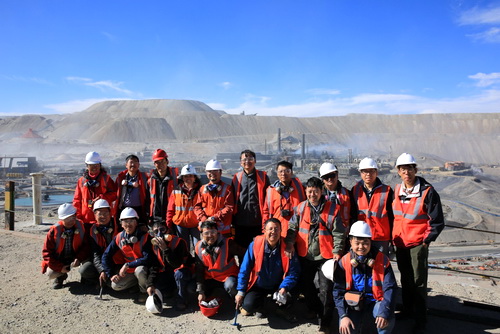|
News Center
|
Top News
IGG members visit Chile’s world-class porphyry copper deposit On August 7-28, at the invitation of Eduardo Campos, an associate professor in School of Geological Science, Universidad Católica del Norte, Chile, a delegation from the Institute of Geology & Geophysics, Chinese Academy of Sciences, visited the porphyry copper deposit in the Andes region of northern Chile. The Major Program of the National Natural Science Foundation of China entitled Large-scale Porphyry Mineralization in Central Asian Metallogenic Domain supported the visit. The visiting delegation was led by Xiao Wenjiao and consisted of 15 researchers from our institute as well as collaborating universities: China University of Geosciences (in Beijing), Peking University, Nanjing University and Jilin University. Chile has some of the world's richest copper ore resources and is the greatest producer and exporter of copper, hence the reputation of being the "Copper Kingdom". The vast majority of copper ore resources are clustered in the Andes porphyry-type Cu-Mo-Au mineralized belt in central and northern Chile, which was produced in a subducion-type magmatic-arc tectonic environment. China is the largest importer of copper ores in the world and one of Chile's most important copper ore trade partners. During the visit, the delegation first visited Universidad Católica del Norte in Antofagasta. The team members held cordial talks with the university's president, with the aims of enhancing the understanding of the present situation of Earth sciences and related disciplines in both China and Chile, and with the aim of developing future cooperation. Afterwards,guided by associate professor Eduardo Campos, the delegation members investigated the Mesozoic Mantos Blancos Copper Mine, the Cenozoic Lomas Bayas Copper Mine, Sierra Gorda, the Chuquicamata Copper Mine, and the Escondida-Escondida Norte-Zaldivar Copper Mine. The members studied the conduit ore-bearing wall rocks, mineragenetic porphyry, mineralization and alteration zoning and secondary enriched oxidation zones in detail and collected a great number of samples. The delegation also explored the different rock units and geologic structural phenomena in the Andes continental marginal arc in northern Chile This included the Jurassic diorite bodies and andesites in the western margin of continental marginal arc near the oceanic trench,the Cenozoic intermediate-basic gabbro/diorite bodies,the intermediate-acid volcanic rocks and fore-arc deposited greywacke which are shifting eastward. They also visited the Thrust Nappe Structure caused by the eastward subduction of the Pacific Plate and the Laco Iron Mine, which is closely related to the Cenozoic volcanic activities. Through their visit and exploration of the world-class porphyry copper deposits and the Andes continental marginal arc in northern Chile, the project team members gained a deeper understanding of the geologic characteristics of the typical porphyry copper deposits under an ocean-to-continent subduction environment and the geologic characteristics of the Andes-type active continental marginal arc constructions. This will help IGG members to make links between the Andean and Central Asian metallogenic domain and provide further insight into porphyry mineralization in the Central Asian metallogenic domain and the subduction-type porphyry mineralization.
The delegation members held talks with the president of Universidad Católica del Norte.
The delegation members investigated Chuquicamata porphyry copper deposit.
|
-
SIMSSecondary Ion Mass Spectrometer Laboratory
-
MC-ICPMSMultiple-collector ICPMS Laboratory
-
EM & TEMElectron Microprobe and Transmission Electron Microscope Laboratory
-
SISolid Isotope Laboratory
-
StIStable Isotope Laboratory
-
RMPARock-Mineral Preparation and Analysis
-
AAH40Ar/39Ar & (U-Th)/He Laboratory
-
EMLElectron Microscopy Laboratory
-
USCLUranium Series Chronology Laboratory
-
SASeismic Array Laboratory
-
SEELaboratory of Space Environment Exploration Laboratory
-
PGPaleomagnetism and Geochronology Laboratory
-
BioMNSFrance-China Bio-mineralization and Nano-structure Laboratory



